After our beautiful wildlife trip in the Okavango, we went for a cultural experience. From Maun, we traveled the long distance to the deserted area of the Tsodilo hills. An area also known as the Mountain of the Gods. We drove up around sunset and we could feel why this area is and has been a sacred area for many different cultures over thousands of years. The mountains arise out of nowhere in an else-wise flat and dry country. In these mountains, there are about 4500 different rock art paintings of which many are over 3000 years old!!
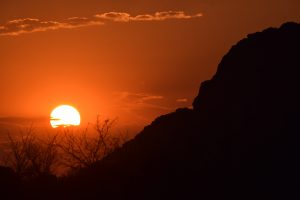
Sun was setting behind the Mountain of the Gods when we arrived. Beautiful!
We arrived at the campsite where we met Craig, a South-African bloke who had been travelling on his own for a while. He and we were happy with the company. We enjoyed a beautiful chatty, star-gazing night together and the next morning we woke up early to hike the hills in the cool of the dawn. We were guided by two local men, Tshebe and Phetolo, who told us everything about the paintings and the area.
Besides visiting the paintings, we also did some rock climbing and caving. Okay, I might make it sound a little bigger than it was, but it was very nice for a change to do some active things instead of sitting in a car the whole day! During the hike, and in one of the caves they showed marks in the rocks. These marks in the shape of holes, were made by the many, many tools that were sharpened so long ago. It was very weird and at the same time impressive to see something so touchable and real like the paintings and these marks, and then realize it was made thousands of years ago by people so alike and yet so different from us.
+Nowadays, however, they still use the holes in the rocks, only not for tool sharpening, but for a game! It’s called Diketo, and works like this: you repeatedly throw a rock up in the air, and while the rock is in the air, you scoop several smaller rocks out of the hole, after which you try and put them back in one by one. Phetolo showed us and made it sound and look very, very easy. But this hand-eye coordination is a lot harder than you might imagine! Lars and Craig both tried, but were failing miserably, throwing rocks in all directions except into the hole! It was kind of dangerous! And I guess, after that, I was afraid to even try. Plus, I might have been a bit more interested in exploring the cave (even though we were told there might be snakes…). By the time we finally got back from our supposed-to-be-2-hour-walk, it was very hot and we took a refreshing shower before we hit the road. As Craig planned to go in the same general direction, we convinced him to join us to the campsite we booked. What we didn’t know was that it was only for 4×4 cars…
When we arrived at the gate, the guy told us we still had to drive about 13 km on a road with a lot of soft sand. And looking at Craig’s car All-Wheel Drive Sabaru, the guy said he probably wouldn’t make it. I suggested he could pack his gear in our car, but with an uncanny amount of faith in his car, Craig said the car could do it! It was sort of a 4×4 after all! The gate guy looked at us sceptically, but let us in anyway… All right, we figured to just give it a try then! And it worked!!! His car kept going, even at the parts I really thought he wouldn’t manage. But then, about halfway to the campsite we had to drive uphill in deep sand, and the clearance of Craig’s car simply wasn’t high enough. So instead of reaching the top of the hill, he ended up on top of the sand just before the top, without any grip with his wheels whatsoever. As this was the third car (and the fifth time) we had to dig out someone else’s car, we were, what you would call, experts. We knew the problem was the clearance and that we had to remove the sand under the car. We knew we had to get some sticks to put under the wheels for some grip. And we knew that if we would push hard enough, while he kept hitting the gas, we would probably be able to get it out. Of course, Craig didn’t know all this, so he was in a bit of a worry, walking around his car frantically, while we were digging the sand from under his car. Then we told him to hit the gas while we pushed. At first, he hit the gas, stopped and hit it again. If you let go of the gas, you just roll back in the hole. We started shouting loudly at him to keep it going and very slowly we pushed the car out and on to the side of the road. As we were only halfway there, we decided to get his gear and leave the car behind. You should know that all of this happened while we were within a game area, were wildlife roams freely. I was explaining to Craig that our experience is that after a shitty ride (or a stuck car) something good is bound to happen here in Africa, especially in game areas. And not even a minute later we almost drove into a pack of wild dogs! And this is a very, very rare sighting, especially as this was a group of about four adults with nine pups! And there they were, right in front of us on the road. The pups were fighting over a kill that had just been brought over by one of the adults! Beautiful! And there is so much interaction amongst wild dogs, we saw one adult arrive and the pups went running towards her and just jumped on top so she rolled over by the force of the pups. After that, she gave them the kill and they ran off and five of them started pulling it in different directions. Lars and I were so happy and excited! At first, Craig was still with his head in worry mode for his car, but he got dragged in by the wild dog’s behaviour and our enthusiasm. And only after we arrived at camp and the staff told us how few wild dogs they saw, and how envious they were, he finally realized how rare this sighting was (even though we had told him). And it hit him (and us) how much luck we had that his car got stuck; we might have missed them if we would’ve been able to continue!
By the time we did arrive at the campsite, it was already dark, but we were lucky enough that the manager had not given our spot away. Again, we had the best spot of the whole campsite right on the edge, next to the river, and some other people kept on insisting they wanted to move there! I don’t know why we are so lucky with these things, but I am really happy we are. We went to put up the tent when Craig finally realized he had forgotten to take the box with his tent in it! It was so funny, and luckily the managers saw the humor as well when we walked back over to the lodge and he booked one of the luxury tents there. After that, we just got a beer at the boma (fireplace) and called it a day. The next morning, we went on a game drive with a local game ranger named Justus who had been working in the conservancy area since 1992. Besides the regular impala, lechwe and hippo, there was not a lot of game that morning, but we almost found lions! And even more important, Justus told us everything about the area. Which was one of the reasons we wanted to visit Nambwa and the Mayuni Conservancy in the first place. We wanted to know more about how this conservancy was set up, and the fact that, in part of it, hunting is allowed.
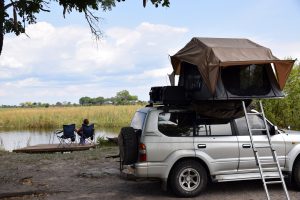
Our beautiful campsite with a deck looking out the river. We heard the hippo’s and saw some lechwe’s right across from us!
This is what we learned. First, let me just say it is a very successful cooperation between community and lodge owners with the aim of conserving nature so they can benefit from tourism. We had not realized this before we visited, so that was a very interesting finding. Mayuni conservancy was the third community conservancy set up in this region, after Salambala conservancy in the East and Wuparo conservancy in the South. It was started by IRDNC (Integrated Rural Development and Nature Conservation), an NGO which works in Namibia and has pioneered one of Africa’s leading models of community-based natural resource management. This is apparent from the successes of the conservancies we have seen in the Caprivi strip region (now called Zambezi-region). Hopefully we will be able to meet with someone from this organization, as we haven’t been able to get in touch yet, but we will try visit their office in the coming month ?.
Anyway, back to the Mayuni conservancy, the area where we saw the wild dogs (yaay!). When IRDNC came in, people were skeptical and suspicious of these people and their plans. However, four volunteers started with demarcating the conservancy area, thereby patrolling the border sort of as anti-poachers. However, in the beginning, they did not have any ammunition besides their hands. Locals just laughed at them. But over time, they received ammunition and even a vehicle and the community came to respect them. In the meantime, a meeting was organized, one with food and beers to make it attractive. And a lot of people showed up and the community came to understand what the conservancy would be all about. For example, if someone has a good well-substantiated idea to start a project, e.g. farming or small craft business or whatever, they can ask money from the conservancy. But they can also ask money for a guiding education, where the conservancy will see it as a way of investing in them. So, the money from the conservancy is coming back into the community. Take for example the campsite we were staying at, Nwambwa. This is a community owned campsite of which the profits all went to the community. Three years ago it was expanded with a lodge, which is partly owned by the community and partly by a British-Namibian investor. But besides the managers and a few game rangers, the rest of the employers are from the community.
Then another part of this conservancy is used for professional hunting. However, oppositely to how they do it around Kafue NP (read it in this blog), here they hunt sustainably. Hunters are not allowed to go without a guide and they can only kill old males; old elephant bulls, kudu’s or old hippo’s. If you ‘accidently’ shoot a female, you’ll have to pay a fine. And if you kill two instead of one animal, you must pay double the amount. And the beautiful thing here is that the conservancies in this area work together: at the end of the year each area does an animal count and if it turns out that for example no elephants are in one area, they will refer to the neighbor. Smart!
Justus, who worked for the hunting company in this area for a few years, told us that he thinks in this region they will probably stop hunting within two years, even though they earn money from it. He says enough money will come in from ‘plain’ tourism just like in Botswana. The main reason however, is that if they continue, they will enter a difficult relationship with their neighbors. In Botswana, hunting is not allowed and without fences separating Namibia and Botswana, the Namibian people are killing the animals that wander across the border. And for Botswana this feels like they are killing ‘their animals’, which makes sense. Furthermore, Justus mentioned that lodges are not the only thing that can provide money or the community. The area also needs for example a fresh vegetable garden, a restaurant, a shopping center and even a bakery. So, there will be enough jobs coming around when tourism picks up! And to show that this model has worked, I can quote Justus: ‘People from the village let lechwe and impala walk in their house and don’t see them as meat, but as a way to earn money from tourism.’ And that is a very good way to preserve nature!!
– Kellie –
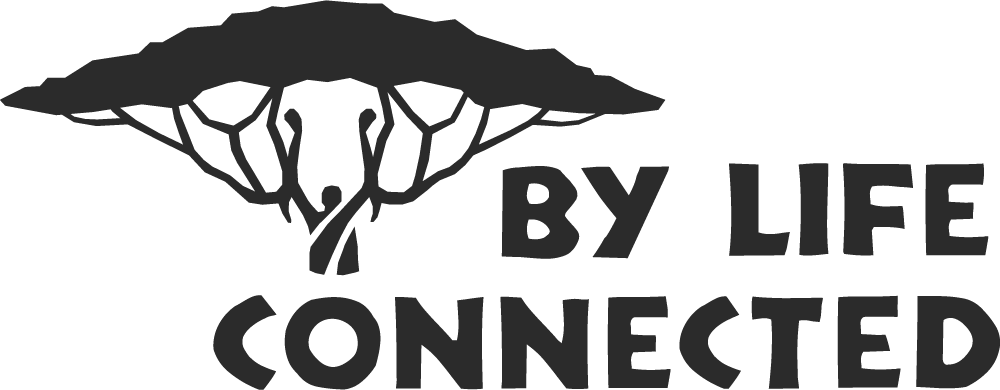
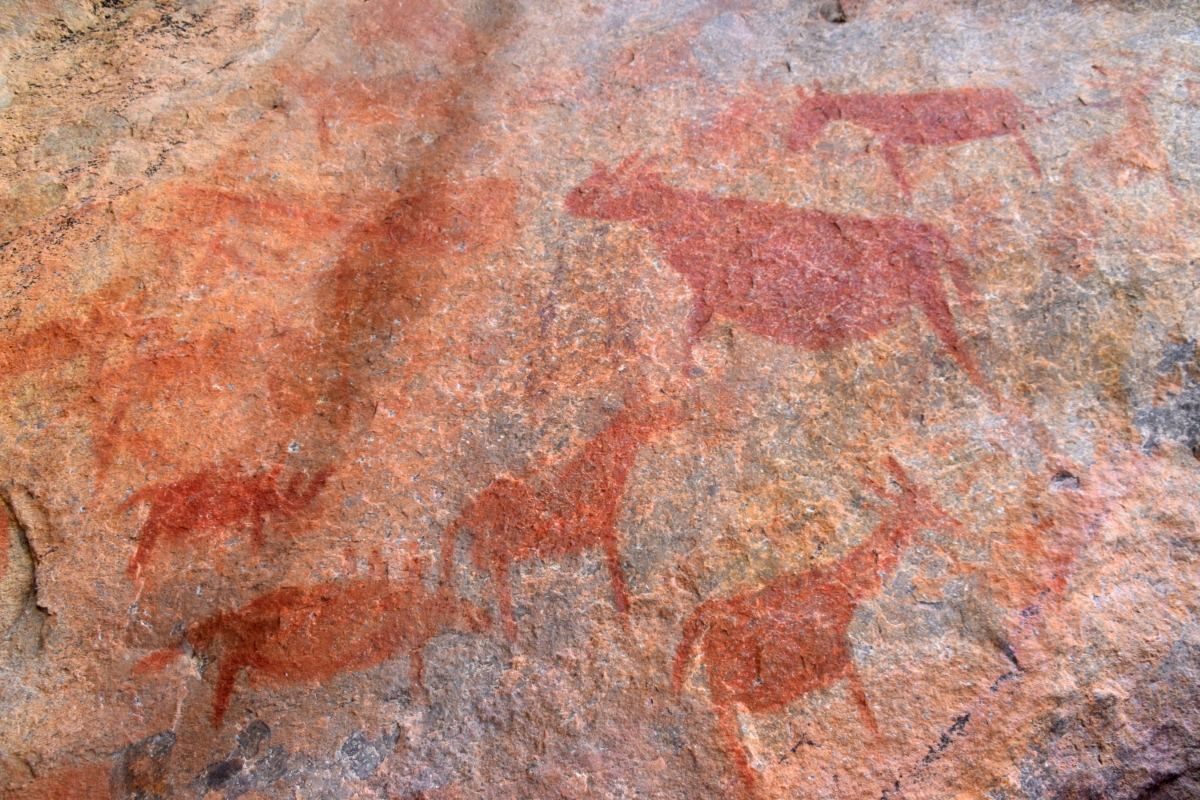
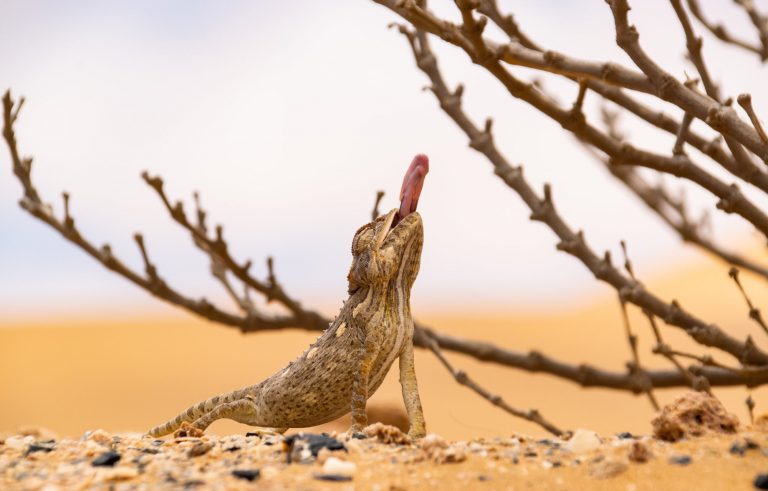


Pingback: Our visit to the Okavango Delta - Everything we could wish for
Pingback: Etosha National Park Namibia - The Arid Eden
Wauw Kel en Lars!
Ziet er goed uit daar en ook mooie verhalen.
Geniet er nog maar lekker van de komende tijd!
x
Pingback: Kaokoveld - a pathway into another world